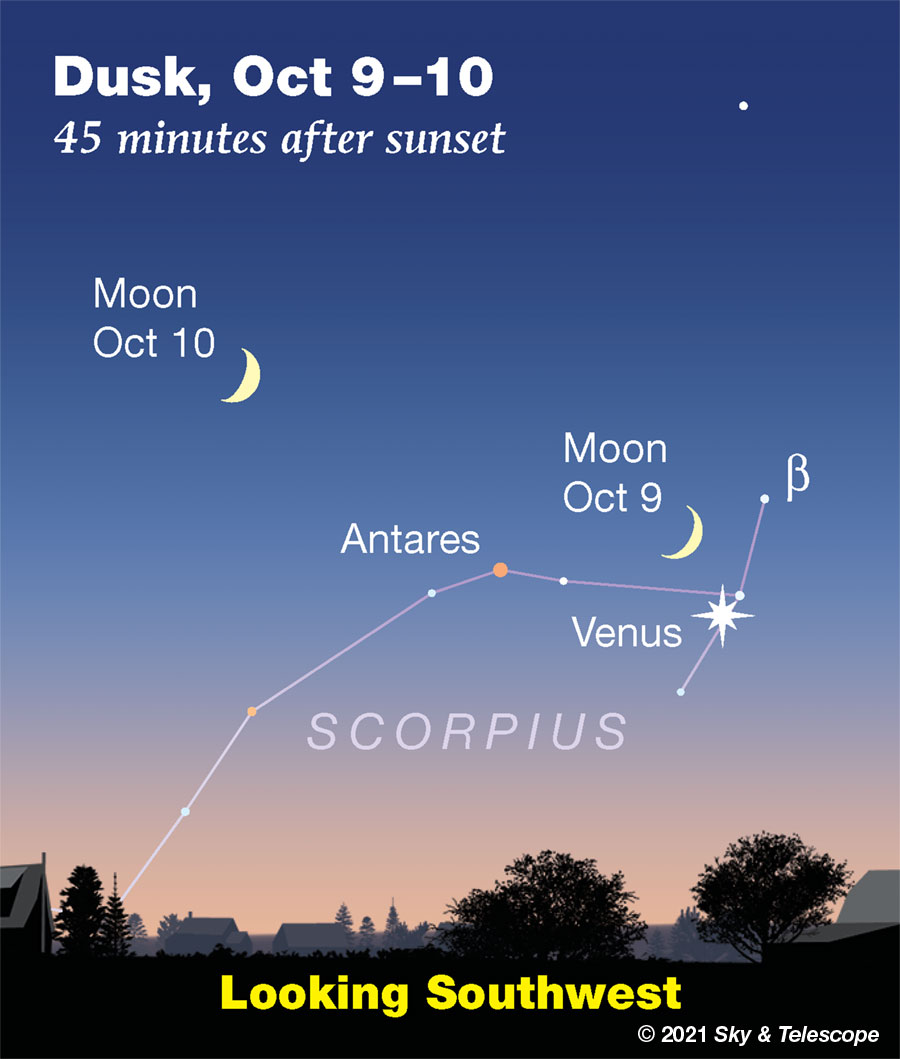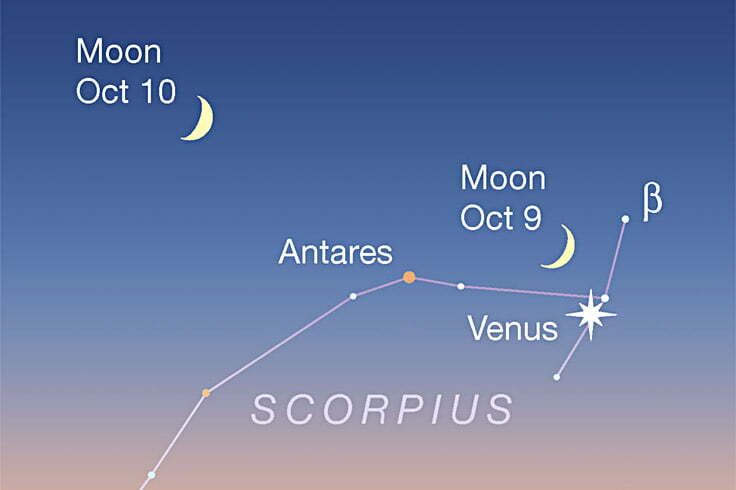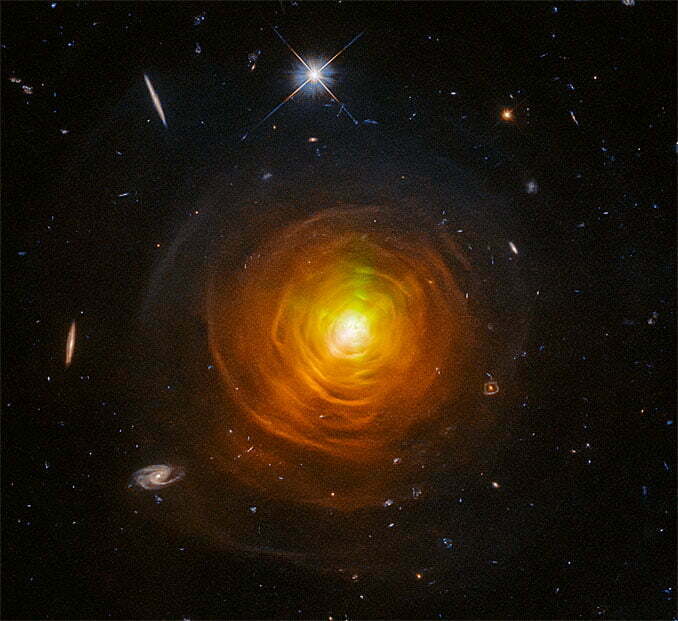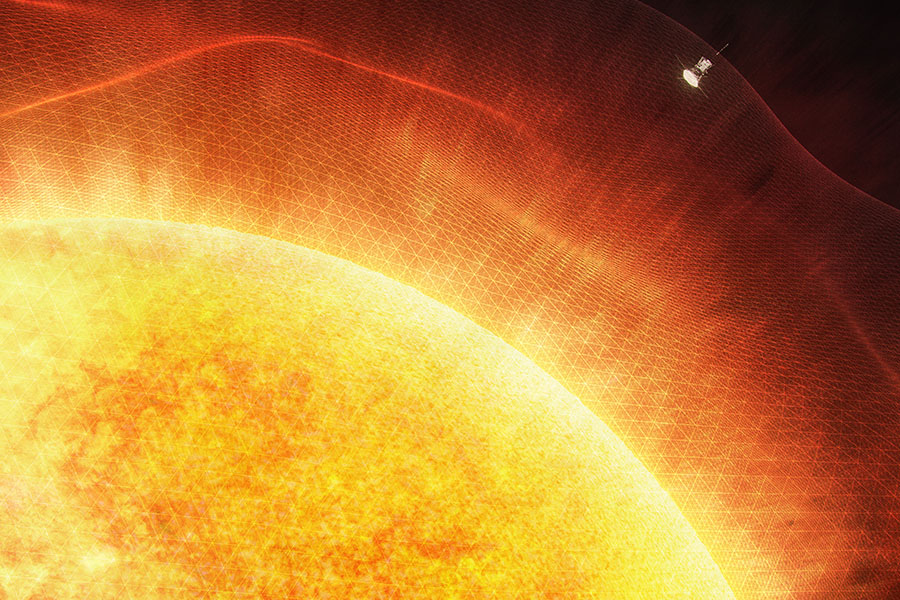This Week’s Sky at a Glance, October 8 – 16 – Sky & Telescope
[ad_1]
Long-lasting Nova Cassiopeiae 2021 was holding at about magnitude 7.6 as of October 7th. That’s as bright as it was when it exploded last March, after all its ups and downs ever since. Charts and comparison stars.
FRIDAY, OCTOBER 8
■ Bright Jupiter and fainter Saturn continue to dominate the southern evening sky this week, 15° apart.
■ This evening, spot Venus low in the southwest as early in twilight as you can. Then look lower right of it by some 12° (about a fist at arm’s length) for the thin crescent Moon. Binoculars help.
If you catch the ideal time window between the sky still being too bright and the Moon sinking too low, you should get a fine view of earthshine dimly lighting the Moon’s nightlands inside the crescent. And the Moon is at perigee today, so it will appear just a little bit larger than average: a supercrescent moon.
You don’t have photometric-quality eyes, but if you did, you might notice that earthshine on the Moon has gotten just a trace dimmer on average in recent years. This is due to a slow change in Earth’s average reflectivity (albedo) over some 20 years due to changing cloudiness trends. The earthshine fade that P. R. Goode and colleagues measured across two decades at Big Bear Solar Observatory is tiny; it amounts to Earth absorbing an additional 0.5 watt per square meter of incoming sunlight on average. But they say this change matches measurements made by other means and is “climatologically significant.”
■ The very weak Draconid meteor shower should be at its peak around this date. But even under ideal dark-sky conditions it usually produces no more than 10 meteors visible per hour. . . and almost nobody’s conditions are ideal.
But unlike most meteor showers, which perform best in the early-morning hours, the best time to watch for Draconids is in the evening, the earlier after dark the better. Why? The shower’s radiant (in the head of Draco) starts the evening high in the northwest and wheels lower as the hours go by.
The meteors are bits of debris from Comet Giacobini-Zinner, so the shower is sometimes called the Giacobinids. It has stormed spectacularly in the past for a few hours or less, notably in 1933 and 1946 and to a lesser extent several times since, but don’t expect that this year; the comet is not near us in its orbit.
■ Jupiter’s Great Red Spot should cross Jupiter’s central meridian around 10:41 p.m. EDT (7:41 p.m. PDT). The Red Spot remains closer to the central meridian than to the planet’s edge for 50 minutes before and after it transits. A light blue or green filter at the eyepiece helps a bit.
SATURDAY, OCTOBER 9
■ Now the Moon shines only about 3° above Venus in twilight (for North America), just while Venus is passing ¾° lower left of 2nd-magnitude Delta Scorpii, as shown below. Bring binoculars!

SUNDAY, OCTOBER 10
■ Did you know that October is aurora season? Your chance of catching a display of the Northern Lights is greater now than average around the year, for reasons having to do with the tilt of Earth’s magnetic axis with respect to the incoming solar wind and the shape of Earth’s magnetosphere. This month the magnetosphere’s northern “throat”is well aimed to swallow charged particles coming from the Sun and steer them down toward the world’s north polar region. Sometimes a gust of particles widens the throat to include lands farther south. The mid-hours of the night are the likeliest time, and of course you want the Moon to have set by then. See the October Sky & Telescope, page 48.
MONDAY, OCTOBER 11
■ Vega is the brightest star very high west of the zenith after dark. Less high in the south-southwest is Altair, not quite as bright. Just upper right of Altair, by a finger-width at arm’s length, is little orange Tarazed. Down from Tarazed runs the dimmer stick-figure backbone of Aquila, the Eagle.
TUESDAY, OCTOBER 12
■ First-quarter Moon (exact at 11:25 p.m. EDT). The Moon shines just east (left) of the handle of the Sagittarius Teapot. Far to the Moon’s upper left are Saturn and then Jupiter.
■ The Great Square of Pegasus balances on its corner high in the east during evening. Away from the Great Square’s left corner runs the main line of Andromeda, three 2nd-magnitude stars about as bright as those of the Square and spaced similarly far apart. (The three include the Square’s corner.) This whole dipper-shaped pattern was named the Andromegasus Dipper by the late Sky & Telescope columnist George Lovi — joining the Big and Little Dippers, the Milk Dipper of Sagittarius (nowadays usually subsumed into the Teapot), and the tiny dipper pattern of the Pleiades.
WEDNESDAY, OCTOBER 13
■ With the season turning chill, Deneb has replaced Vega as the zenith star of early darkness (for skywatchers at mid-northern latitudes). Accordingly, Capricornus has replaced Sagittarius as the zodiacal constellation low in the south. This year, of course, Capricornus is overwhelmed by its two bright guests: Jupiter and Saturn.
■ Jupiter’s Great Red Spot should transit the planet’s central meridian around 9:49 p.m. EDT.
THURSDAY, OCTOBER 14
■ The Moon shines under Jupiter and Saturn, nearly equidistant from them as seen from the Americas in early evening; see the scene below. It’s as if the Moon is swinging in a hammock that’s tied to Jupiter and Saturn at its ends. Much fainter in the background is the hammock shape of Capricornus, larger than the bright one and askew to it.

FRIDAY, OCTOBER 15
■ Spot Venus low in the west in twilight. Just upper right of it, by 1½° (about a finger width at arm’s length), look for orange Antares. It’s less than 1% as bright. Venus stays about this close to Antares for the next two days, but watch their orientation change.
SATURDAY, OCTOBER 16
■ This is the time of year when, soon after nightfall, W-shaped Cassiopeia stands on end halfway up the northeastern sky — and when, off to its left in the north, the dim Little Dipper extends leftward from Polaris.
.
Advertisement
This Week’s Planet Roundup
Mercury emerges into dawn view at the end of this week. By about October 18th, look for it low above the east horizon about 50 minutes before sunrise. Don’t confuse Mercury with Arcturus, which is barely above the northeast horizon (depending on your latitude) way off to Mercury’s left.
Mercury is on its way up toward its best morning apparition of the year. Stay tuned.
Mars remains out of sight, barely past its October 7-8 conjunction with the Sun.
Venus, brilliant at magnitude –4.3, shines low in southwest during twilight, in upper Scorpius. It sets soon after twilight’s end. Venus will pass 1.4° north of Antares on Saturday the 16th.
Jupiter and Saturn continue to shine in the south during evening, 15° apart on opposite sides of Capricornus. Jupiter is the eye-grabber at magnitude –2.7. Saturn, to its right, is a twentieth as bright at mag +0.5.
In late twilight they shine equally high in the south-southeast. As evening progresses watch them tilt as they move to the right, with Saturn becoming the lower one. Saturn sets around 1 a.m. daylight-saving time, followed by Jupiter about an hour later.
After dark look 23° (two fists at arm’s length) lower left of Jupiter for 1st-magnitude Fomalhaut.
Here’s a beginner’s telescopic guide to Jupiter.
Uranus (magnitude 5.7, in southern Aries) climbs high in the east by 11.
Neptune (magnitude 7.8, at the Aquarius-Pisces border) is already well up in the in the southeast by twilight’s end.
All descriptions that relate to your horizon — including the words up, down, right, and left — are written for the world’s mid-northern latitudes. Descriptions that also depend on longitude (mainly Moon positions) are for North America.
Eastern Daylight Time, EDT, is Universal Time minus 4 hours. Universal Time is also known as UT, UTC, GMT, or Z time. To become more expert about time systems than 99% of the people you’ll ever meet, see our compact article Time and the Amateur Astronomer.
Want to become a better astronomer? Learn your way around the constellations. They’re the key to locating everything fainter and deeper to hunt with binoculars or a telescope.
This is an outdoor nature hobby. For an easy-to-use constellation guide covering the whole evening sky, use the big monthly map in the center of each issue of Sky & Telescope, the essential magazine of astronomy.
Once you get a telescope, to put it to good use you’ll need a detailed, large-scale sky atlas (set of charts). The basic standard is the Pocket Sky Atlas (in either the original or Jumbo Edition), which shows stars to magnitude 7.6.

Next up is the larger and deeper Sky Atlas 2000.0, plotting stars to magnitude 8.5; nearly three times as many. The next up, once you know your way around, are the even larger Interstellarum atlas (stars to magnitude 9.5) or Uranometria 2000.0 (stars to magnitude 9.75). And be sure to read How to Use a Star Chart with a Telescope.
You’ll also want a good deep-sky guidebook, such as the big Night Sky Observer’s Guide by Kepple and Sanner.
Can a computerized telescope replace charts? Not for beginners, I don’t think, and not on mounts and tripods that are less than top-quality mechanically, meaning heavy and expensive. And as Terence Dickinson and Alan Dyer say in their Backyard Astronomer’s Guide, “A full appreciation of the universe cannot come without developing the skills to find things in the sky and understanding how the sky works. This knowledge comes only by spending time under the stars with star maps in hand.”
 Audio sky tour. Out under the evening sky with your
Audio sky tour. Out under the evening sky with your
earbuds in place, listen to Kelly Beatty’s monthly
podcast tour of the heavens above. It’s free.
“The dangers of not thinking clearly are much greater now than ever before. It’s not that there’s something new in our way of thinking, it’s that credulous and confused thinking can be much more lethal in ways it was never before.”
— Carl Sagan, 1996
“Facts are stubborn things.”
— John Adams, 1770
[ad_2]
Original Post





Thank you, I’ve recently been looking for info approximately this subject for ages and yours is the greatest I have discovered till now. However, what about the conclusion? Are you positive about the source?
Good site! I really love how it is simple on my eyes and the data are well written. I’m wondering how I might be notified whenever a new post has been made. I have subscribed to your RSS feed which must do the trick! Have a great day!
I have learn a few good stuff here. Definitely value bookmarking for revisiting. I surprise how much attempt you set to create the sort of wonderful informative site.
As soon as I noticed this site I went on reddit to share some of the love with them.
I¦ve learn several excellent stuff here. Definitely worth bookmarking for revisiting. I surprise how much attempt you put to create this type of wonderful informative web site.
Your style is so unique compared to many other people. Thank you for publishing when you have the opportunity,Guess I will just make this bookmarked.2
My spouse and I stumbled over here from a different page and thought I might check things out. I like what I see so now i am following you. Look forward to going over your web page yet again.
very nice put up, i certainly love this website, carry on it
Great write-up, I am regular visitor of one’s web site, maintain up the nice operate, and It’s going to be a regular visitor for a lengthy time.
After examine a number of of the weblog posts in your web site now, and I really like your means of blogging. I bookmarked it to my bookmark website listing and will probably be checking back soon. Pls take a look at my website as effectively and let me know what you think.
Very interesting details you have remarked, thanks for putting up.
I like this post, enjoyed this one thanks for posting.
You have brought up a very great points, thankyou for the post.
Helpful information. Fortunate me I found your website accidentally, and I am shocked why this twist of fate did not came about earlier! I bookmarked it.
Good day very cool web site!! Guy .. Excellent .. Superb .. I will bookmark your website and take the feeds additionally?KI am satisfied to seek out a lot of useful info right here within the submit, we need work out more techniques in this regard, thank you for sharing. . . . . .
you’re actually a good webmaster. The web site loading pace is amazing. It seems that you’re doing any unique trick. Also, The contents are masterwork. you’ve done a great process in this matter!
Hello my family member! I wish to say that this article is awesome, nice written and come with approximately all significant infos. I¦d like to look more posts like this .
Nice post. I learn something more challenging on different blogs everyday. It will always be stimulating to read content from other writers and practice a little something from their store. I’d prefer to use some with the content on my blog whether you don’t mind. Natually I’ll give you a link on your web blog. Thanks for sharing.
hey there and thank you on your info – I have definitely picked up anything new from proper here. I did however expertise a few technical points the use of this site, as I experienced to reload the site a lot of occasions prior to I may just get it to load properly. I have been pondering if your web host is OK? Not that I’m complaining, but slow loading cases instances will often impact your placement in google and can harm your high-quality score if ads and ***********|advertising|advertising|advertising and *********** with Adwords. Well I’m adding this RSS to my e-mail and could glance out for much extra of your respective interesting content. Ensure that you update this again soon..
Fantastic post however , I was wondering if you could write a litte more on this subject? I’d be very grateful if you could elaborate a little bit more. Appreciate it!
Hello.This article was extremely motivating, especially since I was browsing for thoughts on this matter last Saturday.
Hello.This post was extremely interesting, particularly since I was searching for thoughts on this matter last couple of days.
Thanx for the effort, keep up the good work Great work, I am going to start a small Blog Engine course work using your site I hope you enjoy blogging with the popular BlogEngine.net.Thethoughts you express are really awesome. Hope you will right some more posts.
excellent put up, very informative. I ponder why the opposite specialists of this sector do not understand this. You must continue your writing. I’m sure, you have a huge readers’ base already!
of course like your web site but you have to test the spelling on several of your posts. Several of them are rife with spelling problems and I find it very troublesome to inform the reality on the other hand I?¦ll surely come back again.
I believe you have mentioned some very interesting details, regards for the post.
It’s hard to find knowledgeable people on this topic, but you sound like you know what you’re talking about! Thanks
Some really nice stuff on this website , I like it.
Can I just say what a relief to find someone who actually knows what theyre talking about on the internet. You definitely know how to bring an issue to light and make it important. More people need to read this and understand this side of the story. I cant believe youre not more popular because you definitely have the gift.
When I originally commented I clicked the -Notify me when new comments are added- checkbox and now each time a comment is added I get four emails with the same comment. Is there any way you can remove me from that service? Thanks!
Wow that was odd. I just wrote an extremely long comment but after I clicked submit my comment didn’t show up. Grrrr… well I’m not writing all that over again. Regardless, just wanted to say fantastic blog!